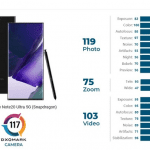
The difference between Samsung smartphones with Snapdragon processors and those with Exynos is a known fact: we talked about it in-depth in a special that took the Galaxy S20 series as an example. But is there anything the Exynos version of a Samsung flagship does better than the Snapdragon equivalent, aside from keeping your hands warm on cold winter days? Apparently yes, at least as far as Galaxy Note 20 Ultra is concerned. According to the DxOMark score, in fact, the Note 20 Ultra’s camera with Exynos performs better than that of the equivalent Snapdragon does.
The score you see above is the one attributed to the model with Qualcomm chip: a total of 117, or 4 points less than the 121 attributed in October to the Exynos version. The devices are identical, except for the processor under the body, and the photographic sector is also exactly the same: a 108 MP main sensor, a 12 MP telephoto lens with 5x optical zoom, and an ultra-wide-angle sensor capable of capturing videos up to a resolution of 8K at 24 fps, or 4K at 60 fps.
In any case, it should be noted that neither of the two models particularly shines for photographic abilities: the performances are good, but not at the top of the sector, and in fact, they both place themselves far from the top 10 in the DxOMark ranking, currently dominated by Huawei Mate 40 Pro.
The strengths and weaknesses are predictably very similar to those already recorded on Note 20 Ultra with Exynos, and therefore vivid colors on most occasions, a very good level of detail in shots, and in videos reliable stabilization and satisfactory noise control both in scenes internal and external. The Achilles heel remains the unreliability of autofocus, not very stable, the skin tone reproduced in videos captured outdoors which tends to be not very credible and a poor level of detail in night photos or in any case taken in contexts of precarious brightness.
Digital marketing enthusiast and industry professional in Digital technologies, Technology News, Mobile phones, software, gadgets with vast experience in the tech industry, I have a keen interest in technology, News breaking.